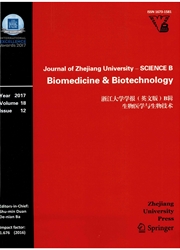

 中文摘要:
中文摘要:
背景和目的:肝新生是调整由的一个复杂过程一组基因并且 epigenetic 因素。许多基因因素被报导了,而很少调查在肝新生期间集中了于 epigenetic 规定。在现在的学习, valproic 酸(VPA ) ,一个 histone deacetylase (HDAC ) 禁止者,被用来在肝上调查 HDAC 的效果新生。方法:VPA 部分予 2/3 经由 intraperitoneal 注射被以在肝期间检测 hepatocyte 增长的 hepatectomized 老鼠新生。老鼠被牺牲,并且他们的肝纸巾在治疗以后从 0 ~ 168 h 在顺序的时间点被收获。DNA 合成经由 BrdU 试金被检测,并且房间增长用 Ki-67 被测试。cyclin D1 的表情, cyclin E, cyclin 依赖者 kinase 2 (CDK2 ) ,并且 CDK4 被西方的污点分析检测。染色质 immunoprecipitation (薄片) 试金被用来检验 HDAC 的招募到目标倡导者区域,目标基因的表示被西方的污点检测。结果:Immunohistochemical 分析证明为 BrdU 和 Ki-67 积极的房间减少了,并且 BrdU 的山峰在管理 VPA 的老鼠被推迟。一致地, cyclin D1 表示也被推迟。我们由互补 DNA (cDNA ) microarray 作为 HDAC 的目标基因识别了 B-myc。B-myc 的表达式在 hepatectomy (PH ) 以后在管理 VPA 的鼠标增加了。薄片试金在 B-myc 倡导者证实了 HDAC 的存在。结论:HDAC 活动为肝新生是必要的。禁止 HDAC 活动推迟肝新生并且导致肝房间周期拘捕,从而在肝上引起 anti-proliferative 效果新生。
 英文摘要:
英文摘要:
Background and objective: Liver regeneration is a complex process regulated by a group of genetic and epigenetic factors. A variety of genetic factors have been reported, whereas few investigations have focused on epi- genetic regulation during liver regeneration. In the present study, valproic acid (VPA), a histone deacetylase (HDAC) inhibitor, was used to investigate the effect of HDAC on liver regeneration. Methods: VPA was administered via in- traperitoneal injection to 2/3 partially hepatectomized mice to detect hepatocyte proliferation during liver regeneration. The mice were sacrificed, and their liver tissues were harvested at sequential time points from 0 to 168 h after treatment. DNA synthesis was detected via a BrdU assay, and cell proliferation was tested using Ki-67. The expres- sions of cyclin D1, cyclin E, cyclin dependent kinase 2 (CDK2), and CDK4 were detected by Western blot analysis. Chromatin immunoprecipitation (CHIP) assay was used to examine the recruitment of HDACs to the target promoter regions and the expression of the target gene was detected by Western blot. Results: Immunohistochemical analysis showed that cells positive for BrdU and Ki-67 decreased, and the peak of BrdU was delayed in the VPA-administered mice. Consistently, cyclin D1 expression was also delayed. We identified B-myc as a target gene of HDACs by com- plementary DNA (cDNA) microarray. The expression of B-myc increased in the VPA-administered mice after hepatectomy (PH). The ChIP assay confirmed the presence of HDACs at the B-myc promoter. Conclusions: HDAC activities are essential for liver regeneration. Inhibiting HDAC activities delays liver regeneration and induces liver cell cycle arrest, thereby causing an anti-proliferative effect on liver regeneration.
 同期刊论文项目
同期刊论文项目
 同项目期刊论文
同项目期刊论文
 Construction of a Portal Implantable Functional Tissue-Engineered Liver Using Perfusion- Decellulari
Construction of a Portal Implantable Functional Tissue-Engineered Liver Using Perfusion- Decellulari 期刊信息
期刊信息
